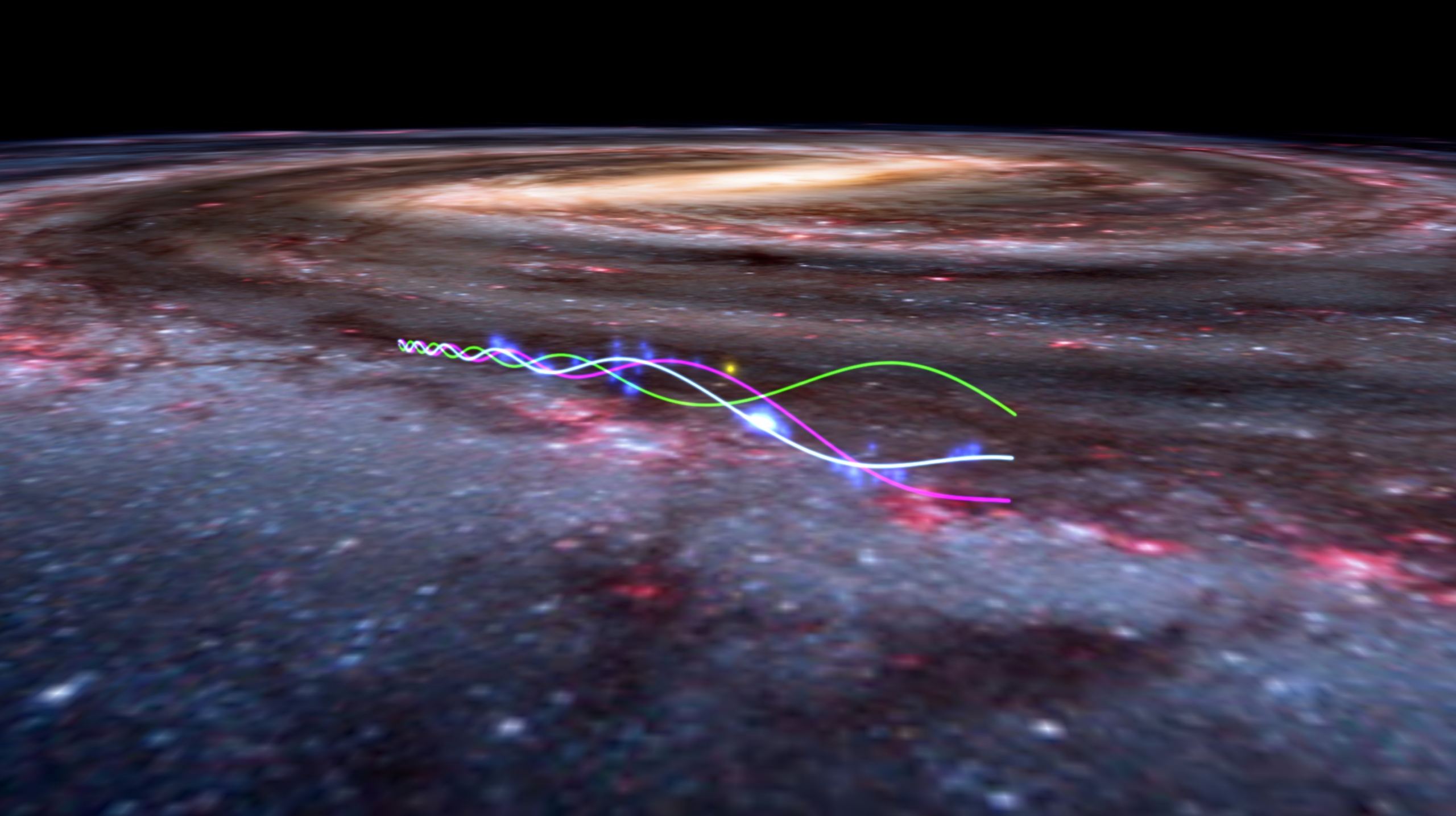Astronomers say there’s a wave rippling through our galactic neighborhood that’s playing a part in the birth and death of stars — and perhaps in Earth’s history as well.
The cosmic ripple, known as the Radcliffe Wave, was identified in astronomical data four years ago — but in a follow-up study published today by the journal Nature, a research team lays out fresh evidence that the wave is actually waving, like the wave that fans in a sports stadium create by taking turns standing up and sitting down.
“Similar to how fans in a stadium are being pulled back to their seats by the Earth’s gravity, the Radcliffe Wave oscillates due to the gravity of the Milky Way,” study lead author Ralf Konietzka, a researcher at Harvard and the Harvard-Smithsonian Center for Astrophysics, or CfA, said in a news release.
The wave — which is named in honor of Harvard Radcliffe Institute, where the undulation was discovered — consists of a string of star clusters spread out over a stretch of the Milky Way measuring about 9,000 light-years in length.
Astronomers reported in 2020 that they identified the wavy pattern by correlating the 3-D locations of the clusters in data from the European Space Agency’s Gaia space telescope, plus observations of dust and gas clouds in the same region.
“It’s the largest coherent structure that we know of, and it’s really, really close to us,” said study co-author Catherine Zucker, an astrophysicist with the Smithsonian Astrophysical Observatory at the CfA. “It’s been there the whole time. We just didn’t know about it, because we couldn’t build these high-resolution models of the distribution of gaseous clouds near the sun, in 3-D.”
At the time, the astronomers didn’t have enough data to determine whether the peak of the wave was rolling down the line. That’s what’s known as a traveling wave, as opposed to a stationary wave — the kind of wave that’s set off, for example, by a vibrating guitar string.
Since then, additional readings about the motion of the star clusters have led the astronomers to conclude that the Radcliffe Wave is indeed a traveling wave that rises to a maximum height of more than 700 light-years and has a mean wavelength of roughly 6,500 light-years.
“Now we can go and test all these different theories for why the wave formed in the first place,” Zucker said.
Konietzka said the potential explanations range from “explosions of massive stars, called supernovae, to out-of-galaxy disturbances like a dwarf satellite galaxy colliding with our Milky Way.”
Astronomers say the wave’s rippling effect could in turn trigger bursts of supernovae and swarms of star formation within the gas and dust clouds of the interstellar medium. In earlier research, Zucker and other astronomers suggested that sometime around 14 million years ago, just such a burst gave rise to the “Local Bubble,” a star-forming shell that surrounds our own solar system.
Other researchers have proposed that the long-lasting fallout from all those supernovae could have affected Earth’s geology and climate — for example, by showering our planet with radioactive dust or perhaps even triggering an ice age.
The Radcliffe Wave is currently about 980 light-years away from our own solar system, and appears to be drifting outward at a speed of about 11,000 mph (5 km/sec). “The measured drift of the Radcliffe Wave radially outward from the galactic center suggests that the cluster whose supernovae ultimately created today’s expanding Local Bubble may have been born in the Radcliffe Wave,” authors of the newly published paper say.
Study co-author Alyssa Goodman, an astronomer at the CfA, said the evidence supports the case for claiming that the Radcliffe Wave had an effect on Earth and its cosmic neighborhood.
“Passage of the sun through over-dense material like the Radcliffe Wave and the Local Bubble does affect the heliosphere,” she wrote in an email, “and the timing does work out that some of the peaks in radioactivity on Earth (e.g., iron-60) line up time-wise with when the sun would have crossed the RadWave, Local Bubble surface, and other ‘Local Fluff’ clouds as well.”
Now the study’s authors are wondering whether the Radcliffe Wave is merely a local phenomenon. Could such waves be common? “The question is, what caused the displacement giving rise to the waving we see?” Goodman said. “And does it happen all over the galaxy? In all galaxies? Does it happen occasionally? Does it happen all the time?”
In addition to Konietzka, Goodman and Zucker, authors of the Nature paper, titled “The Radcliffe Wave Is Oscillating,” include Andreas Burkert, João Alves, Michael Foley, Cameren Swiggum, Maria Koller and Núria Miret-Roig. The research is the focus of a BornCurious podcast titled “Riding the Radcliffe Wave,” as well an online 3-D interactive presented by Cosmic Data Stories and WorldWide Telescope.

